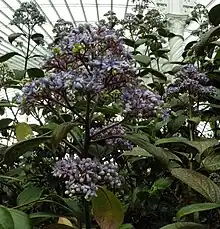| Dichroa febrifuga | |
|---|---|
 | |
| Scientific classification | |
| Kingdom: | Plantae |
| Clade: | Tracheophytes |
| Clade: | Angiosperms |
| Clade: | Eudicots |
| Clade: | Asterids |
| Order: | Cornales |
| Family: | Hydrangeaceae |
| Genus: | Dichroa |
| Species: | D. febrifuga |
| Binomial name | |
| Dichroa febrifuga | |

Dichroa febrifuga is a flowering plant in the family Hydrangeaceae.
National names
Traditional Chinese medicine
Dichroa febrifuga is an important herb in traditional Chinese medicine, where it is considered one of the 50 fundamental herbs.[2] The alkaloids febrifugine and isofebrifugine are believed to be responsible for its antimalarial effects.[3] In traditional preparations, it is used in conjunction with other plants such as Glycyrrhiza glabra (licorice), Ziziphus jujuba and Zingiber officinale (ginger).[4]
Potential drug against autoimmune disease
Halofuginone, sold under the brand name Halocur, is a coccidiostat used in veterinary medicine. It is a synthetic halogenated derivative of febrifugine, a natural quinazolinone alkaloid which can be found in dichroa febrifuga.[5]
Halofuginone inhibits the development of T helper 17 cells, immune cells that play an important role in autoimmune disease, but it does not affect other kinds of T cells which are involved in normal immune function.[6] Halofuginone therefore has potential for the treatment of autoimmune disorders.[7]
References
- ↑ "Dichroa febrifuga". Germplasm Resources Information Network. Agricultural Research Service, United States Department of Agriculture. Retrieved 2008-02-05.
- ↑ "Dichroa febrifuga - Plants For A Future database report". Retrieved 2008-02-05.
- ↑ Zhu, Shuren; Meng, Li; Zhang, Quan; Wei, Lai (2006). "Synthesis and evaluation of febrifugine analogues as potential antimalarial agents". Bioorganic & Medicinal Chemistry Letters. 16 (7): 1854–1858. doi:10.1016/j.bmcl.2006.01.009. PMC 2072810. PMID 16434194.
- ↑ Rasoanaivo, Philippe; Wright, Colin W; Willcox, Merlin L; Gilbert, Ben (2011). "Whole plant extracts versus single compounds for the treatment of malaria: Synergy and positive interactions". Malaria Journal. 10 (Suppl 1): S4. doi:10.1186/1475-2875-10-S1-S4. PMC 3059462. PMID 21411015.
- ↑ "Halofuginone hydrobromide". NCI Drug Dictionary. National Cancer Institute, National Institutes of Health, U.S. Department of Health and Human Services.
- ↑ Sundrud MS, Koralov SB, Feuerer M, Calado DP, Kozhaya AE, Rhule-Smith A, et al. (June 2009). "Halofuginone inhibits TH17 cell differentiation by activating the amino acid starvation response". Science. 324 (5932): 1334–8. Bibcode:2009Sci...324.1334S. doi:10.1126/science.1172638. PMC 2803727. PMID 19498172.
- ↑ Sundrud MS, Koralov SB, Feuerer M, Calado DP, Kozhaya AE, Rhule-Smith A, Lefebvre RE, Unutmaz D, Mazitschek R, Waldner H, Whitman M, Keller T, Rao A (June 2009). "Halofuginone inhibits TH17 cell differentiation by activating the amino acid starvation response". Science. 324 (5932): 1334–8. Bibcode:2009Sci...324.1334S. doi:10.1126/science.1172638. PMC 2803727. PMID 19498172.
- "A new lead for autoimmune disease". EurekAlert! (Press release). 4 June 2009.
External links